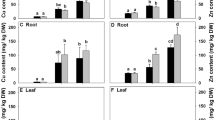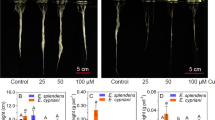Abstract
Cells of the roots ofA. yokoscense growing on metalliferous habitats were fractionated into their cell wall and cytoplasmic components. About 70–90% of the total copper, zinc and cadmium was located in the cell wall. Copper had a markedly greater affinity for the cell wall than zinc and cadmium, and was prevented from entering the cytoplasm. A large proportion of these heavy metals in the cell wall were exchanged as ions. The capacity of the cell wall for exchanging metal ions inA. yokoscense was higher than in other plants growing on metalliferous habitats. However, compared with different ferns unable to grow on metalliferous habitats, this capacity was not unique toA. yokoscense. Consequetly, the root cell wall ofA. yokoscense is considered to be an important site of metal ion storage and may play the role of an excretory organ for heavy metals. On the other hand, as proportion of the heavy metls was transported to the cytoplasm, where the metal content was much higher than the average for normal ferns. This would suggest thatA. yokoscense has another metabolic mechanism related to metal tolerance.
Similar content being viewed by others
References
Antonovics J, Bradshaw AD and Turner RG 1971 Heavy metal tolerance in plants. Adv. Ecol. Res. 7, 2–85.
Bojčenko EA 1968 Chelate compounds of metal in the plants. Successful Modern Biology 66, 173.
Farago ME 1981 Metal-tolerant plants. Chemtech. 11, 684–687.
Honjo T, Hatta A and Taniguchi A 1984 Characterization of heavy metals in indicator plants — Studies on the accumulation of lead and tolerance of gregarious fern,Athyrium yokoscense, in the polluted area from the lead tile of the ruins of Kanazawa Castle. Now the campus of the Kanazawa University — J. Phytogeogr. Taxon. 32, 68–80.
Koval'skij VV and Petrunia NS 1964 Geochemical ecology and evolutional variation of plants. Bull. Aca. Sci. USSR, 159, 1175.
Morrison RS, Brooks RR, Reeves RD, Mallaisse F, Horowitz P, Aronson M and Merriam GR 1981 The diverse chemical forms of heavy metals in tissue extracts of some metallophytes from Shaba province, Zaire. Phytochemistry, 20,1 455–458.
Nishizono H, Suzuki S and Ishii F 1986 Accumulation of heavy metals inAtyrium yokoscense growing on various environments. Plant and Soil (Submitted).
Rauser WE and Curvetto NR 1980 Metallothioneine in occurs in the roots of Agrostis tolerant to excess copper. Nature 287, 563–564.
Turner RG 1970 The subcellular distribution of zinc and copper within the roots of metal tolerant clones ofAgrostis tenuis Sibth. New. Phytol. 69, 725–731.
Turner RG and Marshall C 1971 The accumulation of65Zn by root homogenates clones ofAgrostis tenuis Sibth. New Phytol. 70, 539–545.
Yodafuji K, Hori S and Okuda A 1958 Study on the absorption of base in crops (I) — Cation exchange capacity of root and selectivity of exchange base — J. Jap. Soil Fertil. 29, 27–30.
Author information
Authors and Affiliations
Rights and permissions
About this article
Cite this article
Nishizono, H., Ichikawa, H., Suziki, S. et al. The role of the root cell wall in the heavy metal tolerance ofAthyrium yokoscense . Plant Soil 101, 15–20 (1987). https://doi.org/10.1007/BF02371025
Received:
Revised:
Issue Date:
DOI: https://doi.org/10.1007/BF02371025




